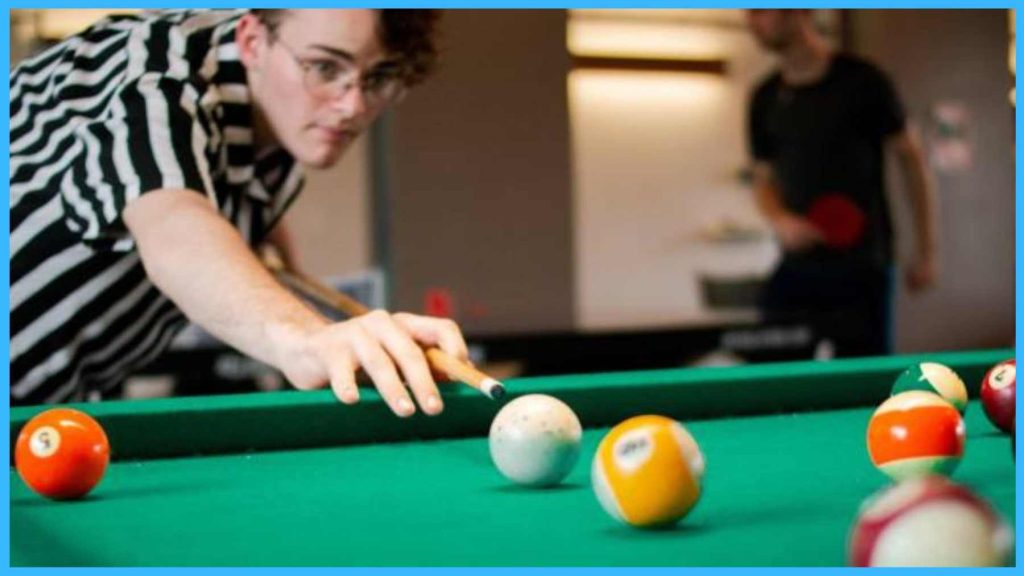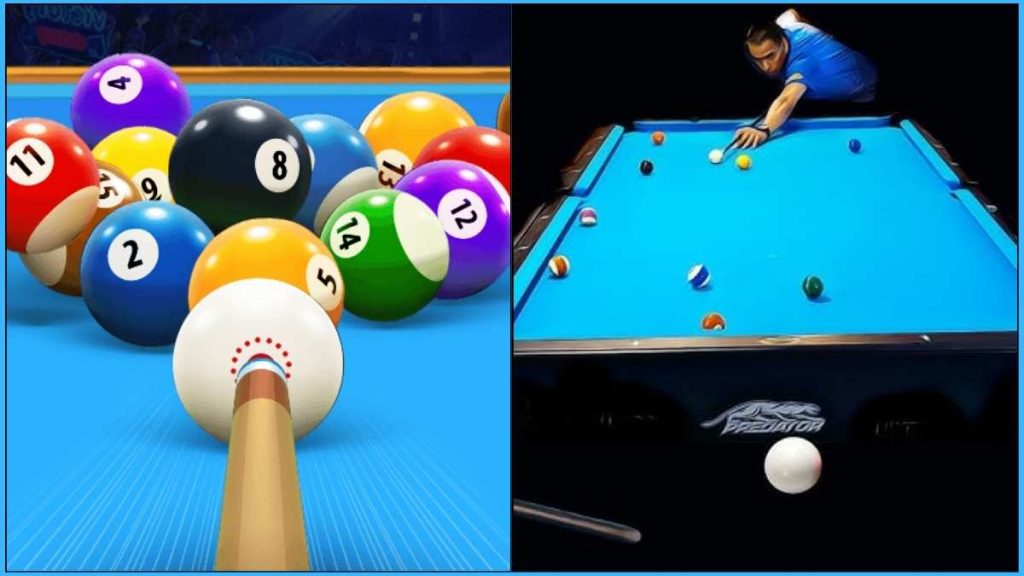Although Cutthroat Pool sounds serious and daunting, trust us, you are in for a ride! The cut throat pool rules make it an exemplary game geared to bring out the best and most competitive side in you. It’s a lot like a regular pool (in most ways), except for one fundamental difference. Here, you play to defeat and win, not to win and defeat! Confused? Let’s unravel this highly sought-after game for a better understanding!
Table of Contents
How To Play CutThroat Pool?
Let’s face it—having an interesting twist in an otherwise fun and exciting game like pool sounds like something with potential! That is exactly what a cutthroat pool is. Unlike in a regular pool, three players can play a game of cutthroat pool at one time.
There are 16 balls in total (15 object balls and 1 cue ball). Each player is designated a set of balls (group) to protect while simultaneously trying to pocket/sink the opponents’ group of balls first. Owing to its nature, the game can get ultra-competitive. But what is the approach to the game? What strategies are employed? What are the Cut Throat Pool Rules? Keep reading to find out!
The Objective
When playing cut throat pool, your objective is to beat the other two players. How do you do that? Well, there are a number of ways you can do that, and it entirely depends on the strategies you employ while following the cut throat pool rules. We will elucidate that later in the article. But, to summarize, the basic objective of the game is to sink the other players’ balls while preventing your opponents from sinking your group of balls.

Cut Throat Pool Rules
A game like a cutthroat pool cannot be played the way it is meant to be played unless the rules of the game are followed. In this section, we shall go over the various cut throat pool rules and regulations of the game so that you get an in-depth understanding of the game’s mechanics.
Playing
There are certain rules that players need to follow when playing a cut throat pool. These rules have been established to promote the etiquette of the game. Some of these 3 player cut-throat pool rules are as follows:
- No player can make direct contact with the ball at any point during a match.
- As per the CutThroat Pool Rules,Players cannot shift or make contact with the opponents’ balls either.
- According to 3 player cut-throat pool rules, resorting to illegal techniques and plays, such as wilful obstruction and hindrances, will be penalized.
- A player cannot hit their own ball. He/she needs to hit the cue ball first, which must hit the opponent’s ball.
- The shot is not counted if a player pockets their opponent’s balls with an illegal shot. The pocketed ball is then returned to its original position on the table, and the player who hit the shot forfeits their turn.
- Per cutthroat pool rules, the player’s turn continues till they fail to make a legal pocket. Once a player fails to pocket a ball legally, the turn passes to the next player.
- Another prerequisite for a legal shot is to ensure that at least one of the balls hits against the inner edge of the pool table (after the cue ball hits a ball from the opponents’ groups).
Choosing The Groups
The basic rule of the cut throat pool states that players should select a group of balls first. But what does that entail? How does that affect the gameplay? In cut throat pool, each player attempts to pocket the opponents’ balls or group of balls. Now, since there are 3 players, there are three groups. Let’s find out what choosing the group means:
- Per cut throat pool rules, there are three groups in the game. The first group consists of balls numbered 1-5. The second group features balls numbered 6-10, and the third one consists of balls numbered 11-15.
- The first player to break gets to choose their group, which they need to protect. Throughout the game, they will attempt to pocket the balls from the other groups to win the game.
- However, there are three approaches to deciding on the groups:
- Traditional Method – In this method, a player can only call their group if s/he pockets two balls (4 and 15) from different groups. In this case, their group would most likely be group 2 (balls numbered 6-10). So, in order to win the game, these balls are to be protected.
- Simpler Method—This is the method that most players resort to when playing casually. In this method, each player can claim a group after pocketing a ball. If you pocket ball number 5 while breaking, you get to pick a group. Then, the next player to sink a ball gets to claim the next group. Unfortunately, the final player is left with no choice but to pick the left-over group.
- Assigning Method—When playing by the assigning method, players are assigned their groups even before breaking. However, the disadvantage of this method is that while breaking, you might end up sinking one of your own balls.

Fouls
As you already read how to play Cut Throat Pool, there are a number of fouls that can be committed during a game of cut throat pool. Scratching, for example, is when the cue ball ends up in one of the pockets after a shot. In cut throat, it is dubbed a foul. Let’s learn about the 3 player cut-throat pool rules and regulations concerning fouls:
- If you sink one of your own balls, it is declared a foul.
- In a case, if the cue ball doesn’t make contact with the opponent’s balls or makes contact with your own ball first, then it is a foul.
- It is declared a foul when a player pockets their own ball with an illegal shot. Although the ball remains pocketed, the next player gets their turn.
- According to cutthroat pool rules, if a numbered ball goes flying off the table, it is declared a foul.
- If the cue ball goes flying off the table, it is also declared a foul. In this case, the next player places the cue ball anywhere he likes on the table.
- Even if a player hits the cue ball twice, it is dubbed a foul.
- Touching the cue ball or any other ball with any part of your body is declared a foul.
- If a player commits the fouls mentioned above, one ball from each of the opponents’ groups that the player has pocketed will be returned to the table.
- But if the player has pocketed no balls from the opponents’ groups, then the foul penalty is not levied.
- Jump shots and scoop shots are also categorized as fouls, per cut throat pool rules.
Important Terms And Definitions
Playing a good game of cutthroat pool will definitely put you on the map as a professional. But what happens if you don’t know the terminologies associated with the game? It doesn’t reflect well, does it? That is why it is of the utmost importance to understand the meanings of some key terms associated with the cutthroat pool.
- Object Balls—Object Balls are basically pocketed or sunk balls numbered from 1 to 15.
- Call Shot—Generally, professional players practice this. Call Shot refers to the action of calling out the ball that you are about to pocket and the pocket where you intend to sink the ball.
- Spotting A Ball – Spotting a ball refers to returning a ball to the table if that ball was:
- Pocketed illegally
- Flew off the table
- Returned to the table after an opponent’s foul
- Foot Spot—According to the cutthroat pool rules, the Foot Spot is basically the dot or marked point near one end of the table, where all the balls are lined up and racked. When racking, the foot spot sits right in the middle of the triangle.
- Baulk Line (Head String) – This line runs across the board, opposite the foot spot.
- Head Spot – This is the other spot on the other end of the table from the foot spot. The cue ball is placed on this spot when breaking. This coincides with the baulk line.

Racking
Racking essentially refers to the process of setting up the balls at the foot spot (see definitions section) using the triangle (see equipment section), before breaking and starting the game. Racking in the cut throat is nearly the same as racking in the pool. Mentioned below are the regulations for racking in cut throat:
- Cut throat pool rules state that place the balls within the triangle, with the center of the triangle placed right over the foot spot.
- To legally rack, the number 1 ball must be at the top corner of the triangle, while balls numbered 6 and 11 should be placed on either corner of the side of the triangle.
- The 8-ball can be in the middle or on the foot spot (like in a pool).
Breaking
After racking comes breaking, which is the second step of the cut throat pool. Breaking is defined as the process wherein a player uses his cue stick to strike the cue ball with force and precision to disperse the rest of the balls (the object balls/balls numbered 1-15) throughout the board.
Breaking is generally the first shot of the game. However, who goes first will be decided by a coin toss, per cutthroat pool rules. Mentioned below are the criteria for a clean and legal break:
- The cue ball has to be placed on the head spot, directly in line with the racked balls.
- The aim should be to try and create opportunities through the break. In other words, the player breaking should try to disperse the object balls while actively trying to sink one or more object balls.
- Another criterion for a legal break is that- at least 4 object balls must bounce off the inside edges of the pool board.
- However, if a player fails to make a clean or a legal break, the next player can ask for the balls to be re-racked. He/she can then proceed to attempt a legal break.
Scoring
According to the official cut throat pool rules, there is no stipulated scoring method. There is only one winner at the end of each match. However, you can set up a scoring method where each player who wins a match is awarded a point. Then, you can decide the number of matches to play. The player who wins the majority of matches or has the highest points after playing the predetermined number of matches wins the entire game.
Winning
If you have played pool, you will find it easy to get accustomed to the rules of cut throat pool. Basically, the way to win in the cut throat pool is to do everything that you do to win at pool – but in reverse. In fact, cut throat pool rules are also quite different. Here, you are to ensure that you pocket all the balls from the two groups assigned to the other two players.
The player who has pocketed all of the opponents’ balls (both groups) and has at least one ball from his own group remaining on the table wins the game. It’s that simple!

Equipment
The equipment needed to play the cut throat pool is similar to the pool. They are:
- A pool table (the same dimensions as a pool table or can vary)
- Cue Sticks (3 in this case)
- A cue ball
- 15 object balls (balls marked 1-15)
- A triangle (the object used to rack the balls before the game begins)
- Cue Chalk (this is rubbed on the end of the cue sticks to ensure crisp and precise contact with the cue ball)
Tips & Strategies
It can be frustrating to lose a game that you are so passionate about. Wouldn’t it be great if you had a few trips and tips up your sleeve? Well, you came to the right place. Listed below are some tips and strategies that will help you improve your cutthroat game exponentially:
- The first thing you need to do is learn how to break properly. Make sure you practice your breaking so that you can pocket at least one ball every time you break. Usually, aiming at the number 1 ball or towards its side (slightly towards either side of that ball) and striking hard increases your chances of pocketing a ball with the break.
- Get low when you hit your shots and generate power from your elbow and up. Keep your fingers loose around the cue stick to prevent misdirection and slipping.
- Your in-game strategy must be twofold: aim to pocket as many opponents’ balls as you can. However, every strike must be well-calculated to make it tough for the opponents to pocket your balls.
- Learn the spin shot. Practice hitting the cue ball at different spots to see the outcome.
- Avoid fouls as much as you can to keep playing your turn.

Alternative Gameplays
There are varying schools of thought when it comes to the cut throat pool rules and gameplay. These schools of thought have given birth to a number of variations of the game, and they are as follows:
- More players – Cut Throat Pool can also be played with more than three players. In such a case, the groups are as follows:
- Two players – 7 balls each
- Four/Five players – 4 balls each
- Six/Seven players – Two Balls Each
- 8-15 players – 1 ball each
- Coin-operated Gameplay—In this variation of the game, if a player scratches, they have to select one of their own balls to pocket. If the player scratches and pots an opponent’s ball, the opponent can pick one ball from that player to pot.
- In North America, a version of cutthroat pool has become really popular. The rules of this game dictate that if a player scratches, the next player gets the cue ball but is only allowed to place that ball behind the baulk line (anywhere but behind the line).
Did You Know?
A game as interesting as cut throat pool comes with its own bucketload of facts. Let’s see how many of these you were already familiar with:
- Cut Throat Pool is also commonly referred to as Three-Man-Screw.
- It likely originated in the United States in the early 20th century.
- The game has been dubbed one of the best games for fostering social interactions and is played on a large scale in pool halls and bars across the United States.
- The game also has a team mode where players can team up and play between themselves.
FAQs
Can I hit my own ball to get another player’s ball in?
No! That is dubbed a foul, per 3 player cut-throat pool rules. The cue ball has to make contact with the opponent’s ball first after striking.
Can you call shots for two balls in one shot?
Depends! If it is mutually agreed upon before starting the game, then yes.
Do I get another chance after sinking my own last ball? Does the game continue?
The game continues only if there are object balls remaining on the table. However, if you sink your own last ball, then you are automatically eliminated.
What if I pocket both my last ball and the last opponent’s ball? What happens then?
It’s a case of scratching while illegally pocketing the opponent’s ball. In this case, either both balls will be returned, or just the opponent’s, and they will be declared the winner.
How to Choose Balls in Cutthroat Pool?
In cutthroat pool, players aim to pocket their assigned balls while avoiding the 8-ball. Each player gets a set of balls (usually 1-5, 6-10, and 11-15). The first player to pocket all their balls wins.
How Do You Play the Cutthroat Card Game?
Cutthroat is a trick-taking game for three players. Each player is dealt 17 cards from a standard deck. The goal is to avoid taking tricks, especially the last one. Players must follow suit if possible, and the player with the lowest score wins.
What Are the Rules for 3-Person Pool?
In 3-person pool, players are assigned different sets of balls. The game is played on a standard pool table with 15 balls and the cue ball. Players take turns shooting, aiming to pocket their assigned balls while avoiding fouls. The first player to pocket all their balls wins.
Pretty simple, right? Once you start playing the game, you will feel a lot more confident about it. Cut-throat pool is a great source of entertainment, after all! However, if you are planning to go professional and actually try to get better at this game, then knowing these cut throat pool rules will help you in achieving your aim. So, rack, break, and win all you want, but play by the rules!
Read More: Cut Throat Pool is certainly a game of repute and now that you know everything there is to know about this game, how about another? Let’s find out how to play Wallyball.

